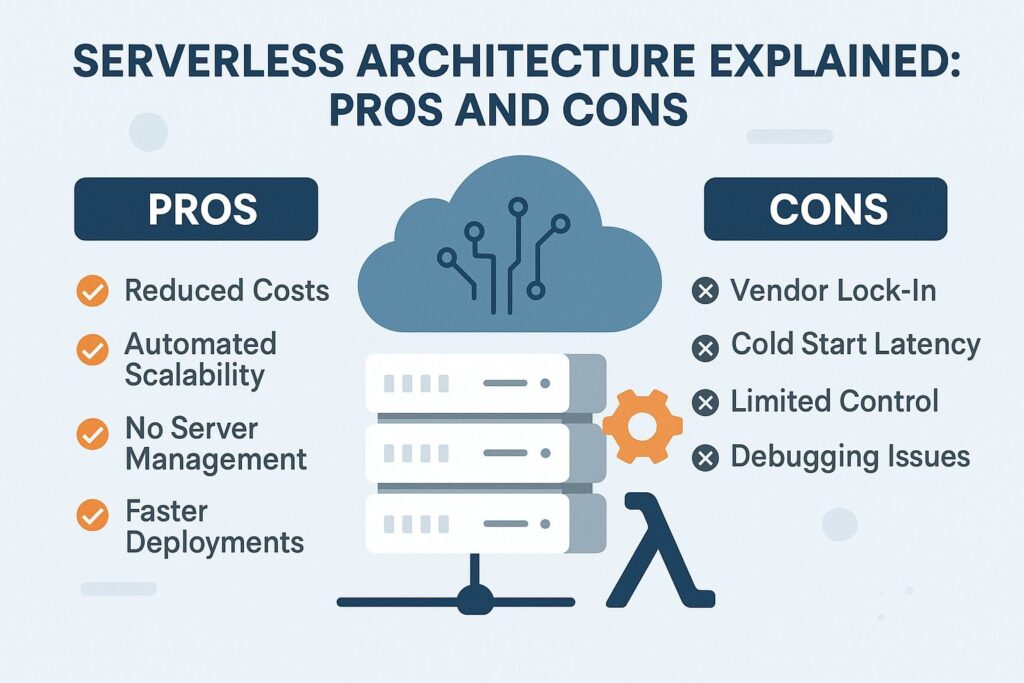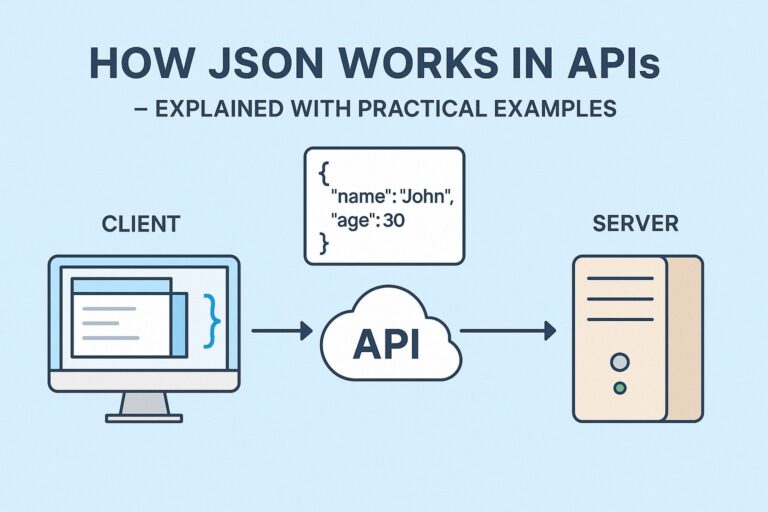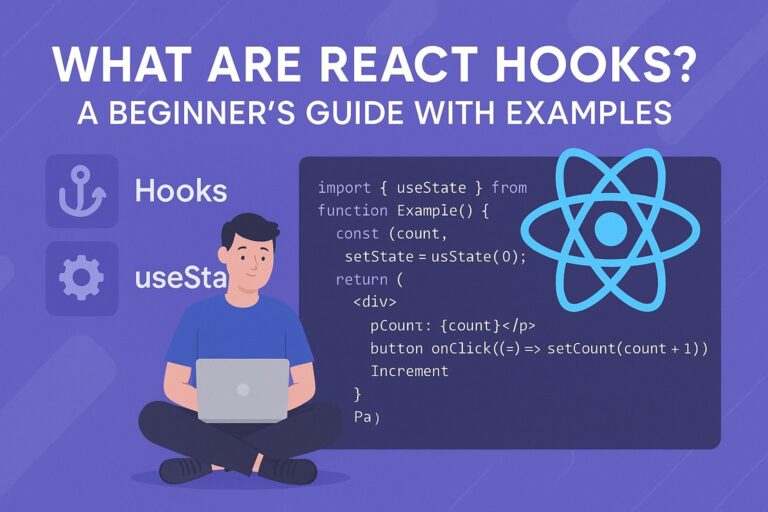
As cloud computing continues to evolve, serverless architecture has emerged as a powerful paradigm shift in how applications are built, deployed, and scaled. Contrary to what the name may suggest, serverless does not mean the absence of servers. Instead, it refers to a cloud computing execution model where cloud providers dynamically manage the infrastructure, allowing developers to focus purely on code and functionality.
Serverless architecture is increasingly being adopted across startups, enterprises, and digital platforms due to its promise of faster development, lower operational overhead, and efficient scaling. However, like any architectural decision, it comes with trade-offs.
This article explores what serverless architecture is, how it works, and the advantages and disadvantages it presents for modern application development.
What Is Serverless Architecture?
Serverless architecture allows developers to build and run applications without managing servers. Instead of provisioning, scaling, or maintaining backend infrastructure, developers write functions or small pieces of logic that are executed in response to specific events.
These functions are typically hosted on Function-as-a-Service (FaaS) platforms such as:
- AWS Lambda
- Azure Functions
- Google Cloud Functions
- IBM Cloud Functions
In addition to FaaS, serverless also encompasses Backend-as-a-Service (BaaS), where cloud providers offer ready-to-use backend features such as authentication, databases, file storage, and APIs.
How Serverless Works
In a serverless environment, applications are broken into small, stateless functions. These functions are triggered by events, such as HTTP requests, file uploads, database changes, or scheduled jobs.
When an event occurs:
- The cloud provider automatically provisions the required computing resources.
- The function executes in a managed container.
- After execution, the container is shut down, and you are only billed for the time your code ran.
This pay-per-execution model eliminates the need to keep servers running 24/7, drastically reducing operational costs for certain workloads.
Key Characteristics of Serverless Architecture
- Event-Driven Execution: Functions are triggered by events and execute on demand.
- Stateless Functions: Each function execution is independent and does not retain any state.
- Automatic Scaling: Functions scale automatically based on the number of requests.
- Micro-billing: Charges are based on actual usage, often measured in milliseconds.
- Managed Infrastructure: No need to provision or maintain servers manually.
Pros of Serverless Architecture
1. Reduced Operational Complexity
Serverless removes the burden of infrastructure management. Developers no longer need to configure virtual machines, handle load balancing, or manage patch updates. This allows teams to focus on writing business logic and deploying features faster.
2. Cost Efficiency
Serverless platforms use a pay-as-you-go model, meaning you only pay for the actual compute time your functions use. This is especially cost-effective for applications with unpredictable traffic or low usage, as there are no costs for idle server time.
3. Seamless Scalability
Serverless functions automatically scale up or down based on demand. Whether you receive ten requests per hour or ten thousand per second, the platform handles scaling transparently without requiring any manual intervention.
4. Faster Time-to-Market
Because infrastructure concerns are abstracted away, development teams can iterate and deploy quickly. Integrating with managed services such as cloud databases, identity management, and messaging queues further accelerates development cycles.
5. High Availability and Fault Tolerance
Most serverless platforms are designed with high availability and fault tolerance built-in. Applications are hosted in multiple availability zones by default, improving reliability without additional configuration.
Cons of Serverless Architecture
1. Cold Start Latency
When a function is invoked after a period of inactivity, the cloud provider may need to initialize the environment—this is known as a “cold start.” Cold starts introduce latency and can impact performance-sensitive applications, particularly for APIs and real-time systems.
2. Limited Execution Time and Memory
Serverless functions are subject to execution limits, typically in the range of seconds to minutes, and may be restricted in terms of memory or CPU. This makes them unsuitable for long-running processes or compute-intensive tasks like video processing or machine learning training.
3. Debugging and Monitoring Challenges
Debugging serverless applications can be more complex due to the distributed, event-driven nature of functions. Traditional debugging tools may not apply, and tracing across services often requires advanced monitoring solutions such as AWS X-Ray, Datadog, or New Relic.
4. Vendor Lock-In
Serverless applications are often tightly coupled with specific cloud providers’ services and runtimes. Migrating to another platform can require significant re-engineering, raising concerns about long-term flexibility and control.
5. Complex Architecture for Larger Applications
While serverless simplifies individual components, large-scale serverless systems may involve hundreds of interconnected functions and services. Managing permissions, dependencies, deployment pipelines, and monitoring can become complex without proper planning and tooling.
Common Use Cases for Serverless Architecture
- API backends for mobile or web applications
- Chatbots and voice assistants
- Real-time file or image processing
- Event-driven workflows (e.g., email notifications, log processing)
- IoT data ingestion and processing
- Scheduled background tasks (e.g., daily reports or batch jobs)
Serverless is ideal for applications with intermittent workloads, asynchronous tasks, or rapid scalability needs.
Tools and Frameworks Supporting Serverless
To streamline serverless development, several frameworks and tools have emerged:
- Serverless Framework: Simplifies deployment to AWS Lambda and other providers.
- AWS SAM (Serverless Application Model): AWS-native tool for building and deploying serverless applications.
- Architect: Lightweight framework for building and deploying serverless web apps.
- Netlify Functions / Vercel Functions: Ideal for serverless apps on JAMstack platforms.
These tools offer configuration templates, monitoring integrations, and support for CI/CD pipelines.
Final Thoughts
Serverless architecture represents a significant evolution in how applications are developed and deployed. It offers numerous benefits, including scalability, reduced operational overhead, and cost efficiency, making it an attractive option for many modern applications. However, it is not a one-size-fits-all solution.
Organizations should evaluate serverless against their specific needs, workload patterns, and development team expertise. For stateless, event-driven use cases with unpredictable traffic, serverless can provide a fast, scalable, and cost-effective solution. For latency-sensitive, long-running, or compute-heavy workloads, traditional or containerized architectures may still be more appropriate.
A strategic and well-informed approach to adopting serverless architecture will ensure that businesses can maximize its advantages while mitigating potential drawbacks.

I’m Shreyash Mhashilkar, an IT professional who loves building user-friendly, scalable digital solutions. Outside of coding, I enjoy researching new places, learning about different cultures, and exploring how technology shapes the way we live and travel. I share my experiences and discoveries to help others explore new places, cultures, and ideas with curiosity and enthusiasm.






